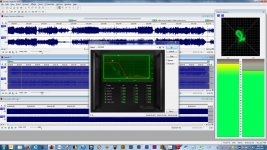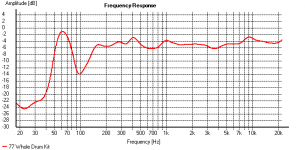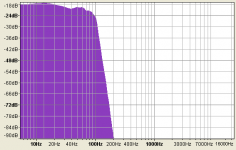I checked a 1968 album called Super Session ripped using the original LP with a Shure V15 Type II cartridge and M-Audio Audiophile Firewire audio interface to Sound Forge 10. A Mastering Effects filter was applied with heavy roll-off above 200Hz. There's lots of out-of-phase bass present as displayed in the SF 10 Phase Meter Lissajous pattern. I also converted the two filtered stereo tracks to mono using "difference mode," which should have cancelled any in-phase bass and it still had plenty of amplitude.
How do I post an image here–I have no website, so can't provide a URL to an image.
Years ago when Quadraphonic sound was introduced many people (self inculded) connected two rear mounted speakers together with the rear - (negative) speaker inputs connected together and the + (positive) to the right and left channel outputs. If the bass was truly monophonic then it should have been cancelled in the rear speakers, but that was not the case with many recordings. The solution was to use small speakers that had poor bass response, which allowed hearing the out-of-phase material as an added "ambienence."
Click on the "post reply" button, not the quick one.
Scroll down you will see "manage attachments", click on that then browse to the location of the image on your computer.
It helps if you re-size images to around 800-1200 pixels wide using MS paint etc if the images are large.
Sound Forge 10 Visual Phase Analysis
Thank you H E Pennypacker.
Click on the "post reply" button, not the quick one.
Scroll down you will see "manage attachments", click on that then browse to the location of the image on your computer.
Apparently you can't do that using 'Edit' a post, so I added a URL link using a file download site. Here's the same image:
Thank you H E Pennypacker.
Click on the "post reply" button, not the quick one.
Scroll down you will see "manage attachments", click on that then browse to the location of the image on your computer.
Apparently you can't do that using 'Edit' a post, so I added a URL link using a file download site. Here's the same image:
Attachments
Files are here:
https://www.dropbox.com/sh/4601rq758dxqwx5/Z_4stleTVD
This is noise with a steep low pass filter, about 60dB/octave. You should hear it pan back and forth. This is an amplitude only pan. All are at -14dB RMS, except the 40Hz file, which is 2dB louder. Let me know what you hear.
https://www.dropbox.com/sh/4601rq758dxqwx5/Z_4stleTVD
This is noise with a steep low pass filter, about 60dB/octave. You should hear it pan back and forth. This is an amplitude only pan. All are at -14dB RMS, except the 40Hz file, which is 2dB louder. Let me know what you hear.
Very cool Pano, thanks for that.
The dog got up and ran to the door when I played the 80 hertz file. It sounds similar to a UPS pulling up the driveway I suppose.
The dog got up and ran to the door when I played the 80 hertz file. It sounds similar to a UPS pulling up the driveway I suppose.
Chris, here is your Alan Parsons drum lit run thru the grinder. Obviously just from listening it's a very stereo track. The graph shows the the level of difference vs sum of the part with the toms. Mostly difference is about 5dB below sum. But there are some big peaks and valleys. I assume from the drums that are way off center and those that are more centered.
Attachments
Files are here:
https://www.dropbox.com/sh/4601rq758dxqwx5/Z_4stleTVD
This is noise with a steep low pass filter, about 60dB/octave. You should hear it pan back and forth. This is an amplitude only pan. All are at -14dB RMS, except the 40Hz file, which is 2dB louder. Let me know what you hear.
Thanks!
Looked at spectrograms of the files. There seems to be localizable content. Can you localize the 40Hz sample?
By the way, it would probably be better to use an uncompressed format and not mp3.
Edit 1: Could you do the pan smoother and slower?
Edit 2: Could you do a second set of files for headphones that pan slowly around and close to the center?
Last edited:
This thread has surpassed my original intent by quite a ways. A lot of good info is coming out--thanks guys!
I'd say this is becoming enough of a resource that it should be moved to the subwoofer category. What say ye, mods?
Sent from my v89_jdt1qhd using Tapatalk
I'd say this is becoming enough of a resource that it should be moved to the subwoofer category. What say ye, mods?
Sent from my v89_jdt1qhd using Tapatalk
I doubt for this wav would be any better than MP3. I can check spectrum of each. I'll will try a slower and smoother pan.
The filter is pretty tight. On the 100 Hz file it's down over 40dB at 150Hz. You'll not find any sub that does that.
Looks good to me. The 100Hz pan is down about 66 db at 200Hz:
SF 10
Attachments
Yes please.
I guess I should of mentioned that I could distinguish every one them.
I did have to turn up the volume a bit on the 60 hertz and a bit more on the 40 hertz as I am using a little SE with smaller console transformers at the moment.
I guess I should of mentioned that I could distinguish every one them.
I did have to turn up the volume a bit on the 60 hertz and a bit more on the 40 hertz as I am using a little SE with smaller console transformers at the moment.
You should have to turn up the lower tones no matter what. That's how the ear works.
OK, I'll post some more stereo bass files later. These will be much more subtle. And there will be a test. 🙂
OK, I'll post some more stereo bass files later. These will be much more subtle. And there will be a test. 🙂
Thanks Shaner.
Markus, can you play FLAC files? Anyone else?
Why not use WAV or AIFF?
Here's an idea.
Stereo subs.
Record or play back something like a drum track solo stand up bass or other sound that consists of a higher freq component and a substantially low frequency component, where it is recorded with a clear balance to the left or right.
Reverse the channels for the subs, keep the HF speakers the same.
Still sound ok?
This is a fast way to test for a somewhat radical time difference between the mains and subs.
-------------------
I was thinking a bit about the dB balance thing at LF.
I strongly doubt that one would hear small differences in LF imbalance *alone* without the presence of a higher frequency component. Along the lines of what I was talking about earlier, my experience is that with proper time relationships between the component parts of the speaker system (subs to mains for example) reasonable imbalance in sub amplitude for a given channel will alter the tonal perception not the spatial perception. Whereas changing the time relationships will alter the apparent spatial perception, if compared to a "proper" time relationship.
Stereo subs.
Record or play back something like a drum track solo stand up bass or other sound that consists of a higher freq component and a substantially low frequency component, where it is recorded with a clear balance to the left or right.
Reverse the channels for the subs, keep the HF speakers the same.
Still sound ok?
This is a fast way to test for a somewhat radical time difference between the mains and subs.
-------------------
I was thinking a bit about the dB balance thing at LF.
I strongly doubt that one would hear small differences in LF imbalance *alone* without the presence of a higher frequency component. Along the lines of what I was talking about earlier, my experience is that with proper time relationships between the component parts of the speaker system (subs to mains for example) reasonable imbalance in sub amplitude for a given channel will alter the tonal perception not the spatial perception. Whereas changing the time relationships will alter the apparent spatial perception, if compared to a "proper" time relationship.
I promised to report back on converting my mono-sub system to stereo. This involved replacing the monoblock amp with a stereo one, re-matching levels, and removing the mixing. So far, I really don't hear any notable difference, nor did I expect to.
- Status
- Not open for further replies.
- Home
- Member Areas
- The Lounge
- Can the human ear really localize bass?




